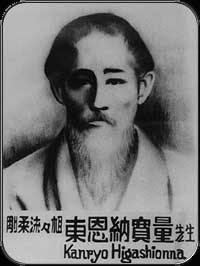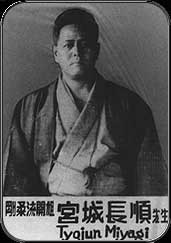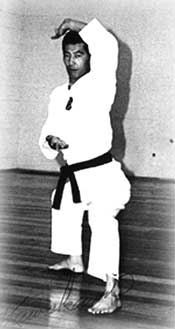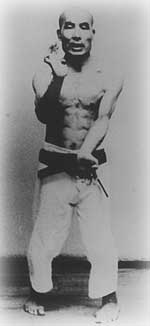What Is Goju?
by Jon Reingold & Christopher L. Chin

This principle would be the ability in one instant to be relaxed and in the next instant to be fully powered up. This can be illustrated by the development of the body, through Sanchin training, to "turn on" in an instant in order to become armored to protect against any attack; then, just as quickly, to "turn off" the power and become supple enough to counter-attack with lightening quickness. A more spiritual interpretation of the hard-soft philosophy 'would be the strength to withstand life's stresses and strains while remaining compassionate warm-hearted in our conduct toward others.
A Little Okinawan History
 Okinawa,
also known as the Ryukyu Islands, is quite far from the rest of Japan.
For many centuries the Okinawans traded predominantly with the Chinese.
Okinawan culture, as a result, was greatly influenced by the Chinese.
In fact, Okinawa was not even part of Japan until the Japanese invaded
and occupied the country and subjugated the people.
Okinawa,
also known as the Ryukyu Islands, is quite far from the rest of Japan.
For many centuries the Okinawans traded predominantly with the Chinese.
Okinawan culture, as a result, was greatly influenced by the Chinese.
In fact, Okinawa was not even part of Japan until the Japanese invaded
and occupied the country and subjugated the people.
You may have realized by now that the philosophy of the balance of hard-soft, as well as other seemingly opposite ideas, is not unique to Goju. For centuries the Chinese have understood the balance of apparent opposites, of Yin/Yang -, of a universe balanced by opposing forces blending into each other, with a little of each represented in the heart of the other. It is clear these Chinese concepts found their way into Okinawan culture.
Goju-Ryu
is also a melding of native Okinawan martial arts (Naha-te, literally
hands of Naha, a city in Okinawa) with certain martial arts of Fukien
Province of southern China. It was Higashionna Kanryo who traveled from
Okinawa to Fukien Province and combined these arts to form Naha-te. Higashionna
Sensel traveled to China as a teenager to learn martial arts. He trained
and lived with a martial arts master named Ryu Ryu Ko. The arts they
trained included Fukien White Crane, which is characterized by powerful
short range movements, quick long range movements, circular motions,
and harmony of breath and motion (Sound familiar?). Several years after
he returned to Okinawa, Higashionna began teaching. Higashionna was 49
years old when he took on a 14 year old student named Miyagi Chojun...
Chojun (Tyajun) Miyagi
 Chojun
(Tyajun) Miyagi was born on April 25,1888. He began his Karate training
Shuri-te and at the age of 14 was introduced to Kanryo Higaonna with
whom he began his study of Naha-te. Like his teacher before him, because
of his great talent and determination, he progressed rapidly. Chojun
Miyagi became "uchi deshi" (private discipline) of Kanryo
Higaonna. He stayed with his teacher for 14 years before his teacher's
passing in 1915.
Chojun
(Tyajun) Miyagi was born on April 25,1888. He began his Karate training
Shuri-te and at the age of 14 was introduced to Kanryo Higaonna with
whom he began his study of Naha-te. Like his teacher before him, because
of his great talent and determination, he progressed rapidly. Chojun
Miyagi became "uchi deshi" (private discipline) of Kanryo
Higaonna. He stayed with his teacher for 14 years before his teacher's
passing in 1915.
Chojun Miyagi, as successor to Naha-te pushed himself to the limits of endurance in his desire to emulate his teacher's extraordinary skill. In 1915 he journeyed to the Fukien Province in China, where his teacher had studied martial arts nearly a half decade earlier, to further his research. This was one of three trips he made to China during his lifetime.
Chojun Miyagi worked hard to spread Goju-Ryu Karate throughout Okinawa,Japan, Asia and the Pacific and to earn Goju-Ryu a status equal to that of the highly respected Japanese martial arts. To achieve this he traveled frequently to mainland Japan where he was invited to teach at Kyoto University, Kansai University and Ritsumei Kan University. In 1933, Goju-Ryu Kara-te was the first Okinawan martial art to be registered at the Dai Nippon Butoku-Kai, the center for all martial arts in Japan.
Chojun Miyagi dedicated his whole life to Kara-te. He was responsible for structuring Goju-Ryu into a systemize discipline which could be taught to people in general. The system that he designed enabled Kara-te to be taught for the benefit of the young and old to reach large numbers of people all over the world. His teachings at his home remained strictly in adherence to the principles and traditions of his teacher, Kanryo Higaonna, and his teacher before him, Ryu Ryu Ko. Grandmaster Chojun Miyagi passed away in 1953.
Tutors and Influences

Sensei Akira Kawakami -- performing Kata Sanseiru in Oklahoma City Dojo. Circa:
1968 |

Reverend Sogen Sakiyama -- Buddhist Zen Priest. Kata Sanchin - at the end. The Reverend was a participating student of Great Grand Master Chojun Miyagi and had learnt many Goju Katas prior the war. Circa:
Summer, 1971 |
| Contact Gusi Sensei (gusi_g@msn.com) |